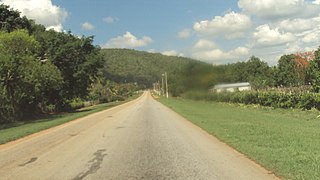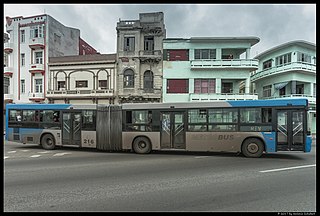 W
WHavana is the capital and largest city of Cuba. The heart of the La Habana province, Havana is the country's main port and leading commercial center. The city has a population of 2.1 million inhabitants, and it spans a total of 781.58 km2 (301.77 sq mi) – making it the largest city by area, the most populous city, and the fourth largest metropolitan area in the Caribbean region.
 W
WThe Autopista A1, also known as Autopista Nacional, is a Cuban motorway, partly built, that will link Havana to Guantánamo. It is a toll-free road and its total length will be of about 900 km (560 mi). Along with the Autopista A4, linking Havana to Pinar del Río, it is classified as part of the whole Autopista Nacional route, spanning the length of the island; as the Carretera Central highway.
 W
WThe Autopista A2, also known as Primer Anillo de La Habana, is a Cuban motorway serving the city of Havana, that connects almost all of the Cuban motorways to each other. It is a toll-free road and has a length of 36 km (22 mi).
 W
WThe Autopista A3, also known as Autopista Havana-Melena, is a Cuban motorway linking Havana to Melena del Sur. It is a toll-free road and has a length of 32 km (20 mi).
 W
WThe Autopista A4, also known as Autopista Este-Oeste or Autopista Nacional Este-Oeste, is a Cuban motorway linking Havana to Pinar del Río. It is a toll-free road and has a length of 156 km (97 mi). Along with the Autopista A1, partly built, that will link Havana to Guantánamo, it is classified as part of the whole Autopista Nacional route, spanning the length of the island; as the Carretera Central highway.
 W
WThe Autopista del Mediodía is a Cuban motorway linking Havana to San Antonio de los Baños. It is a toll-free road and has a length of 18 km (11 mi).
 W
WThe Autopista Havana–Mariel, also known as Carretera Panamericana, is a Cuban motorway linking Havana to Mariel. It is a toll-free road and has a length of 26 km (16 mi). Even though it is a motorway (autopista), it is part of the national highway Circuito Norte (CN).
 W
WThe Carretera Central (CC), meaning "Central Road", is a west-east highway spanning the length of the island of Cuba.
 W
WThe Circuito Norte (CN), meaning "Northern Circuit", is a west-east highway spanning the length of the island of Cuba, through the Atlantic Coast. With a length of 1,222 km, it is the second-longest Cuban highway, after the "Carretera Central"; and two sections of it, named "Vía Blanca" and "Panamericana", are classified as motorways (Autopistas).
 W
WCiudad Libertad Airport is an airport serving Havana, Cuba. and formerly known as El Aeropuerto de Columbia. Located in the borough of Playa, it was Cuba's main airport until 1930, when it was replaced by José Martí International Airport. The airport was also the location of the 1960 Cuban Grand Prix. Two days prior to the Bay of Pigs Invasion in 1961 the airport was bombed by US planes. It is now used as a military airport, and is now surrounded by the city. It previously had two runways, but only one remains.
 W
WFaro Castillo del Morro is a lighthouse located in Havana, Cuba. It was built in 1845 on the ramparts of the Castillo de los Tres Reyes Magos del Morro, an old fortress guarding the harbor of Havana. The lighthouse has a height of 25 metres (82 ft), a focal height of 44 metres (144 ft) and displays two white flashes every 15 seconds.
 W
WHavana Harbor is the port of Havana, the capital of Cuba, and it is the main port in Cuba. Other port cities in Cuba include Cienfuegos, Matanzas, Manzanillo, and Santiago de Cuba.
 W
WHavana Central is the main railway terminal in Havana and the largest railway station in Cuba, is the hub of the rail system in the country. It serves for the arrival and departure of national and divisional commuter trains, and is home to the national railway company, Ferrocarriles Nacionales de Cuba (FFCC), the only intercity passenger rail transport operating in the Caribbean.
 W
WThe Hershey Electric Railway, also known as the Hershey Railway, is a standard-gauge electric interurban railway that runs from Casablanca, Havana, to the city of Matanzas, approximately 92 kilometres (57 mi) to the east. There are a number of intermediate halts and a station and depot at the town of Camilo Cienfuegos, better known by its pre-revolutionary name of Hershey. The railway is the only surviving electric line in Cuba. The railway was built by The Hershey Company to transport sugar to the port of Havana. The original electric interurban cars were bought from the JG Brill Company, but these were replaced by 60-year old cars from the Ferrocarrils de la Generalitat de Catalunya in the 1990s.
 W
WJosé Martí International Airport, sometimes known by its former name Rancho Boyeros Airport, is an international airport located 20 km (12 mi) southwest of the centre of Havana, Cuba, and is a hub for Cubana de Aviación and Aerogaviota, and former Latin American hub for the Soviet airline Aeroflot. It is Cuba's main international and domestic gateway, and serves several million passengers each year. The airport is operated by Empresa Cubana de Aeropuertos y Servicios Aeronáuticos (ECASA).
 W
WThe Havana MetroBus, shortened as MB, is a public bus network serving the city of Havana, capital of Cuba. It is the principal public transport network of Cuban capital and is conceived as a surface subway.
 W
WPlaya Baracoa Airport is an airport west of Havana, Cuba. It is located in the municipality of Caimito, Artemisa Province, in front of the village of Playa Baracoa, belonging to the neighboring municipality of Bauta.
 W
WThe Havana Suburban Railway is a passenger rail network serving the city of Havana, capital of Cuba, and its suburbs. Owned by the national company Ferrocarriles de Cuba, it represents the only suburban rail system of the Caribbean island.
 W
WVía Blanca is a highway in northern Cuba, connecting the capital city of Havana and the city of Matanzas. A second section extends eastwards from Matanzas to the tourist town of Varadero and to Cárdenas. Even if it is a motorway (autopista), it is part of the national highway named "Circuito Norte" (CN).